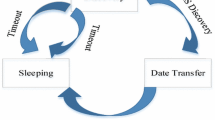Abstract
In WSNs (Wireless Sensor Networks), data storage and retrieval is a challenging problem because of the limited resource and the short communication radius of the sensor nodes. Most of the existed schemes choose one or more static sensor nodes or Sinks to act as the rendezvous nodes, which can be seen as the connectors between the data producers and the data consumers. However, those schemes cannot avoid both the “hot spot” problem and the “bottleneck” problem, which refer to the much higher load balance of the sensor nodes around the rendezvous nodes. Moreover, most of the existing schemes never consider the dynamic nature of WSNs, which leads to the lack of adaptability. In this paper, we propose a novel dynamic-optimization-based framework named SRMSN using mobile Sinks to solve such a problem. SRMSN utilizes two heuristic methods, which are based on the virtual-grid-division technology and the diversity-factor-analysis technology, to determine the optimal target locations of the mobile Sinks in each time interval when each Sink node stay at a certain position and the optimal length of each of the time intervals adaptively, aiming at improving the adaptability and the efficiency of WSNs on data storage and retrieval. Simulation results show that SRMSN can reduce and balance the energy consumption greatly as well as decrease the average delay of data storage and retrieval in comparison with the state-of-the-art scheme on data storage and retrieval in WSNs.








Similar content being viewed by others
References
Borgia, E. (2014). The Internet of Things vision: Key features, applications and open issues. Computer Communications, 54(1), 1–131.
Fu, Z., Wu, X., Guan, C., et al. (2016). Towards efficient multi-keyword fuzzy search over encrypted outsourced data with accuracy improvement. IEEE Transactions on Information Forensics and Security, 11(12), 1.
Intanagonwiwat, C., Govindanj, R., & Estrin, D. (2000). Directed diffusion: A scalable and robust communication paradigm for sensor networks. In Proceeding of the 6th annual international conferenceon on mobile computing and networking(MobiCOM’00), (pp. 56–67).
Shenker, S., Ratnasamy, S., Karp, B., et al. (2003). Data-centric storage in sensor nets. ACM SIGCOMM Computer Communication Review, 33(1), 137–142.
Madden, S., Franklin, M. J., & Hellerstein, J. M., et al (2002). TAG:A tiny aggregation service for ad-hoc sensor networks. In Proceeding of the 5th symposium on operating system design and implementation, (pp. 131–146).
Braginsky, D., & Estrin, D. (2002). Rumor routing algorithm for sensor networks. In Proceedings of the 1st workshop on sensor networks and applications, (pp. 22–31).
Ratnasamy, S., Karp, B., & Yin, L. et al. (2002). Ght: A geographic hash table fordata-centric storage. In Proceedings of the first ACM international workshop on wireless sensor networks and applications (WSNA’02), (pp. 56–67).
Lai, Y., Chen, H., & Wang, Y. (2007). Dynamic balanced storage in wireless sensor networks. In Proceedings of the 4th workshop on data management for sensor networks, (pp. 7–12).
Biswas, R., Chowdhury, K., & Agrawa, D. P. (2006). Attribute allocation and retrieval scheme for large-scale sensor networks. International Journal of Wireless Information Networks, 13(4), 303–315.
Liao, W.-H., & Wan-Chi, W. (2008). Effective hotspot storage management schemes in wireless sensor networks. Computer Communications, 31(10), 2131–2141.
Ma, K. T., Cheng, K. Y., Liu, K. S., et al. (2009). Improving data centic storage with diffuse caching in wireless sensor networks. Wireless Communications and Mobile Computing, 9(3), 347–356.
Le, H.-C., Guyennet, H., & Zerhouni, N. (2007). Mobile effect reduction in data-centric storage for wireless sensor networks. In Proceedings of the 3rd IET international conference on intelligent environments (IE 07), (pp. 304–311).
Sarkar, R., Zhu, X., & Gao, J. (2006). Double rulings for data storage and retrieval in sensor networks. In Proceedings of the 12th annual international conference on mobile computing and networking (MobiCom’06), (pp. 286–297).
Fang, Q., Gao, J., & Guibas, L. J. (2006). Landmark-based information storage and retrival in sensor Networks. In Proceedings of 25th IEEE international conference on computer communications (INFOCOM2006), (pp. 1–12).
Yu, Z., Xiao, B., & Zhou, S. (2010). Achieving optimal data storage position in wireless sensor networks. Computer Communications, 33(1), 92–102.
Ma, X., & Xue, Y. (2012) Adaptive information brokerage in wireless sensor networks with mobile sinks. In Proceedings of the 12th IEEE international conference on computer and information technology, (pp. 1–4).
Zhu, L., Weimin, G., Hong, J., & Deng, X. (2015). Adaptive information brokerage of multiple storage nodes in optical sensor networks. Optik—International Journal for Light and Electron Optics, 66(1), 81–86.
Karp, B., & Kung, H. T. (2000). GPSR: Greedy perimeter stateless routing for wireless networks. In Proceedings of the 6th annual ACM/IEEE Int’l confernce on mobile computing and networking, (pp. 243–254).
Shen, J., Tan, H., Wang, J., et al. (2015). A novel routing protocol providing good transmission reliability in underwater sensor networks. Journal of Internet Technology, 16(1), 171–178.
Xie, S., & Wang, Y. (2014). Construction of tree network with limited delivery latency in homogeneous wireless sensor networks. Wireless Personal Communications, 78(1), 231–246.
Acknowledgement
This research is supported by NSFC (Natural Science Foundation of P. R. China, No. 61562005, 61402393), CSC (China Scholarship Council, No. 201508410271), the Natural Science Foundation of Henan Province of P. R. China (162300410234), the Nanhu Scholars Program for Young Scholars of XYNU, and the supporting program of young backbone teachers in Xinyang Normal University in Henan Province of P. R. China.
Author information
Authors and Affiliations
Corresponding author
Additional information
Publisher's Note
Springer Nature remains neutral with regard to jurisdictional claims in published maps and institutional affiliations.
Rights and permissions
About this article
Cite this article
Ma, X., Li, Y., Wang, T. et al. Achieve Adaptive Data Storage and Retrieval Using Mobile Sinks in Wireless Sensor Networks. Wireless Pers Commun 101, 1731–1747 (2018). https://doi.org/10.1007/s11277-018-5788-0
Published:
Issue Date:
DOI: https://doi.org/10.1007/s11277-018-5788-0




